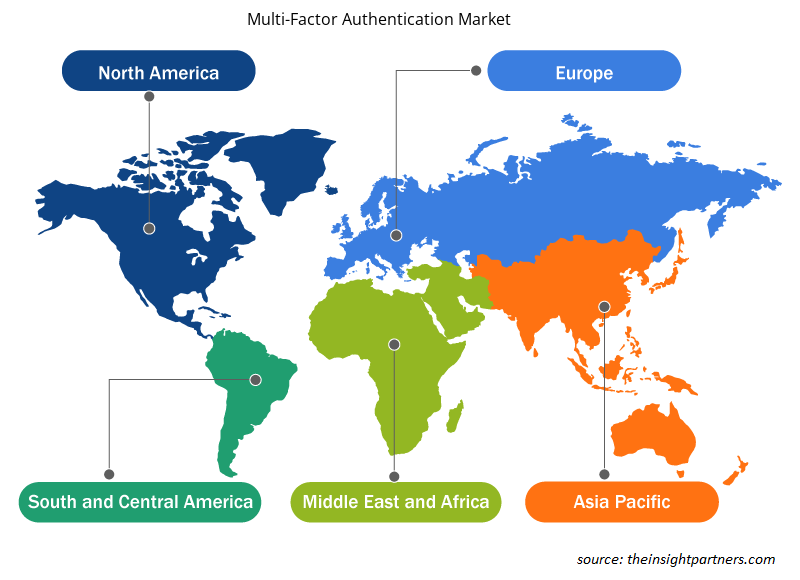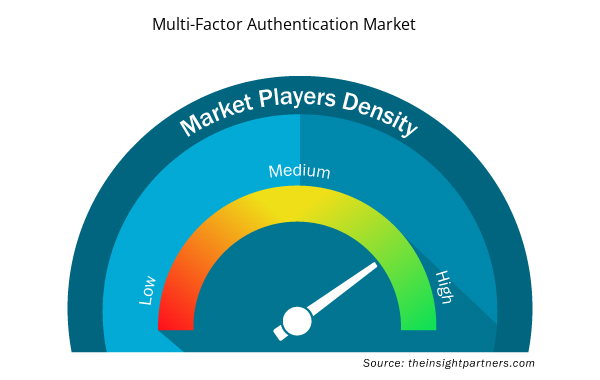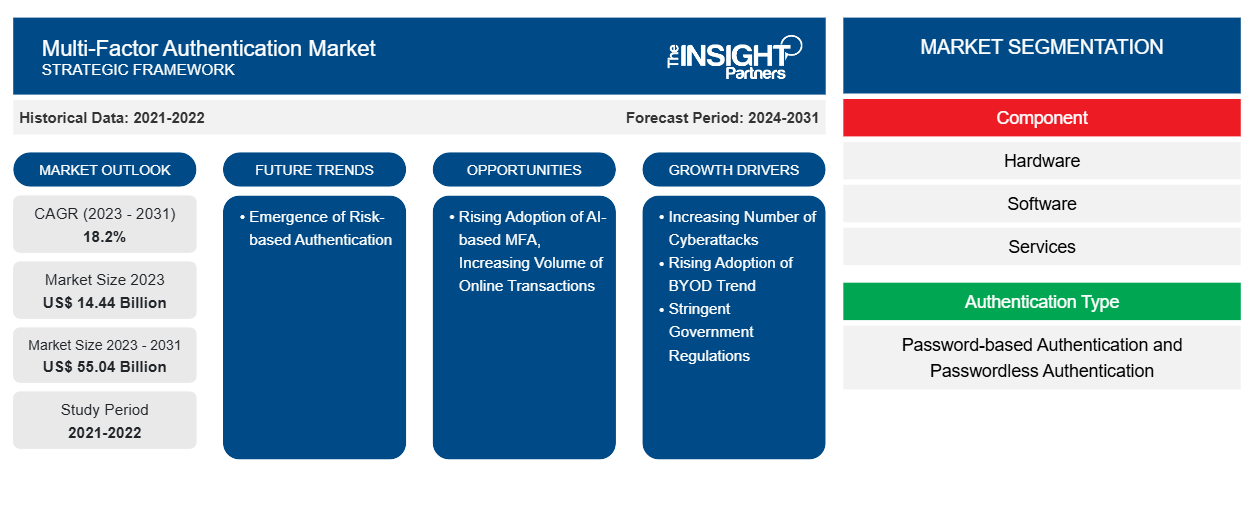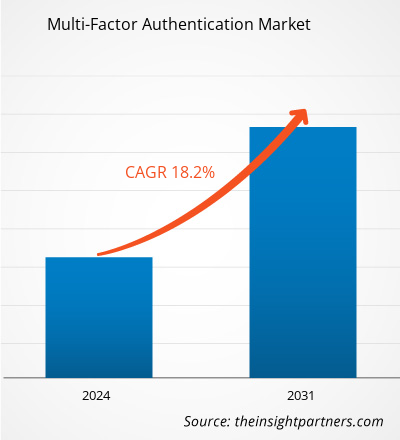多要素認証市場規模は、2023年の144.4億米ドルから2031年には550.4億米ドルに達すると予測されており、2023年から2031年にかけて18.2%のCAGRを記録すると推定されています。
リスクベースの認証は、多要素認証市場の主要なトレンドであり続けると思われます。
多要素認証市場分析
今日のビジネス環境では、企業やユーザーが重要かつ機密性の高い情報をオンラインで保存するため、デジタル セキュリティが重要です。インターネット経由で保存されるサービス、アプリケーション、データとのやり取りが増加しています。このオンラインに保存された情報のデータ漏洩や悪用は、深刻な金銭的盗難、ビジネスの混乱、プライバシーの喪失につながる可能性があります。このようなシナリオでは、多要素認証ソリューションが保護を提供し、追加のセキュリティ レイヤーを作成して、権限のないユーザーがオンライン アカウントにアクセスするのをブロックします。企業は、多要素認証ソリューションを使用して、ユーザーの ID を検証し、承認されたユーザーに迅速かつ便利なアクセスを提供します。COVID-19 危機の影響により、多くの企業がリモート ワーク ソリューションを採用せざるを得なくなり、多要素認証は企業のデータを保護するための要件になりました。大多数の企業が多要素認証ソリューションの導入を開始しています。さらに、MFA の採用は、消費者データを保護するためのサイバー セキュリティ強化に関する政府の規制によって主に推進されました。さらに、ますますコストがかかる攻撃と BYOD のトレンドの高まりにより、組織は多要素認証ソリューションの採用と導入を大幅に推進しています。
多要素認証市場の概要
多要素認証 (MFA) とは、パスワードだけでなく、複数ステップのアカウント ログイン プロセスを伴う認証方法を指します。多要素認証 (MFA) ソリューションでは、アプリケーション、オンライン アカウント、VPN などのリソースにアクセスするために、ユーザーは 2 つ以上の検証パラメータを提供する必要があります。MFA は ID およびアクセス管理の重要なコンポーネントであり、権限のないユーザーが重要なアカウントにアクセスするのを防ぐための追加のセキュリティを実現します。多要素認証の目的は、物理的な場所、ネットワーク、コンピューティング デバイス、データベースなどのリソースへのサイバー攻撃のアクセスを困難にする階層化された防御を作成することです。MFA には、信頼性の向上、コストの削減、組織のセキュリティの強化、シングル サインオン (SSO) との互換性など、さまざまな利点があり、規制コンプライアンスへの準拠やエンタープライズ モビリティの実現も可能です。
要件に合わせてレポートをカスタマイズする
このレポートの一部、国レベルの分析、Excelデータパックなど、あらゆるレポートを無料でカスタマイズできます。また、スタートアップや大学向けのお得なオファーや割引もご利用いただけます。
- このレポートの主要な市場動向を入手してください。この無料サンプルには、市場動向から見積もりや予測に至るまでのデータ分析が含まれます。
多要素認証市場の推進要因と機会
企業全体におけるサイバー攻撃の増加
近年サイバー犯罪が拡大しており、企業はサイバー犯罪の脅威に常にさらされています。Embroker Insurance Services LLC によると、サイバー攻撃は 2020 年に 5 番目にリスクが高いとされ、技術の進歩に伴い、その件数も増え続けています。コンピューター マルウェア、データ侵害、サービス拒否 (DoS) などは、サイバー リスクの例です。COVID-19 パンデミックの間、サイバー犯罪者は、企業がリモート ワーク環境に移行しているときに、ネットワークの不整合を悪用しました。 OneLoginによると、サイバー犯罪による全世界の被害額は1兆ドルを超え、2020年には37%の組織がランサムウェアの被害を受け、61%がマルウェア攻撃の被害に遭いました。2019年から2020年にかけて、米国ではサイバー攻撃が139%増加し、2020年第3四半期には1億4,520万件という驚異的な件数を記録しました。マルウェア攻撃は2019年と比較して2020年に358%増加しました。同様に、Clusit Reportによると、世界中のサイバー攻撃は2021年に前年と比較して10%増加しています。たとえば、AAGによると、2022年のインターネットユーザー100万人あたりのサイバー犯罪被害者数は英国が最も多く(4,783人)、2020年の数字から40%増加しました。 2022年のサイバー侵害の平均コストは435万ドルで、この値は2025年までに10.5兆ドルに達すると予測されています。多要素認証は、企業がオンライン攻撃から身を守るために採用できる最も重要なソリューションとして浮上しています。Microsoftによると、多要素認証ソリューションを使用すると、すべての攻撃の99.9%をブロックできます。したがって、企業におけるサイバー攻撃の増加が多要素認証市場を牽引しています。
AIベースのMFAの採用増加
多要素認証 (MFA) は、システムにログインする際にユーザーが複数の形式の ID を提供する必要があるセキュリティ ソリューションです。多要素認証は不正アクセスを防止するために不可欠なツールであり、近年ますます一般的になっています。多要素認証での AI の使用は比較的新しい開発です。ユーザーの行動を分析して ID を確認できるため、認証の一般的な選択肢になると予想されています。
多要素認証 (MFA) における AI の使用は、セキュリティ対策を強化し、機密情報を保護するための強力なツールとして浮上しています。AI テクノロジーを活用することで、組織は多要素認証ソリューションの有効性と回復力を高め、潜在的なリスクを軽減し、デジタル ID を強化できます。AI などのテクノロジーは、多要素認証システムのセキュリティを向上させるためにさまざまな方法で使用できます。AI ベースの MFA システムは時間の経過とともに学習して適応できるため、不正行為を特定して阻止する能力がますます向上します。さらに、AI によるリアルタイムの ID 検証により、ハッカーがユーザーになりすますことが困難になります。多要素認証における AI の最も有望な用途の 1 つは、行動バイオメトリクスです。行動バイオメトリクスを通じて、AI はユーザーの行動を分析し、それを既知のパターンのデータベースと比較することで、ユーザーの ID を検証します。行動バイオメトリクスを使用して、システムはユーザーのタイピング スタイル、電話の持ち方、さらには特徴的な歩き方まで監視します。今日の企業はセキュリティの向上を目指しており、AI ベースの多要素認証システムの導入が増えています。また、リアルタイムでユーザーの身元を確認するためにも使用できます。したがって、AI ベースの MFA の採用が増加することで、予測期間中に多要素認証市場の成長に有利な機会が生まれると予想されます。
多要素認証市場レポートのセグメンテーション分析
多要素認証市場分析の導出に貢献した主要なセグメントは、展開、規模、およびアプリケーションです。
- コンポーネントに基づいて、市場はハードウェア、ソフトウェア、サービスに分類されます。2023 年には、ソフトウェア セグメントが市場で大きなシェアを占めました。
- 認証タイプに基づいて、市場はパスワードベースの認証とパスワードレス認証に分かれています。2023 年には、パスワードベースの認証セグメントが市場を支配しました。
- モデルタイプに基づいて、多要素認証市場は、2要素認証、3要素認証、4要素認証、5要素認証に分類されます。2023年には、2要素認証セグメントが市場を支配しました。
- エンドユーザーに基づいて、市場はITおよび通信、BFSI、教育、政府、ヘルスケア、その他に分類されます。2023年にはITおよび通信セグメントが市場を支配しました。
地域別の多要素認証市場シェア分析
- 多要素認証市場は、北米、ヨーロッパ、アジア太平洋 (APAC)、中東およびアフリカ (MEA)、中南米の 5 つの主要地域に分かれています。2023 年には北米が市場を支配し、続いてヨーロッパ、中南米、APAC が続きました。
- 北米は、技術革新と先進技術の採用の両面で最も急速に成長している地域の1つです。この地域には、確立されたITおよびクラウドインフラストラクチャもあります。過去3年間、北米では、すべての主要な業界分野で人工知能、機械学習、ブロックチェーンなどの新興技術の大規模な採用が見られました。さまざまな業界でデジタル化が浸透するにつれて、検証と認証は、特に金融機関やオンライン小売業において、ビジネストランザクションエコシステムの重要なコンポーネントになりました。企業における多要素認証ソリューションの需要は、これらのソリューションにより企業がさまざまな規則や規制に準拠できるため、急速に高まっています。これらの規制のいくつかには、マネーロンダリング防止(AML)、顧客確認(KYC)、デジタル詐欺防止が含まれます。北米の多要素認証市場の成長は、サイバー攻撃からの保護が事業の成功に不可欠なビジネス要件であるBFSI、政府、防衛、医療などの産業部門からの需要の高まりによって主に推進されています。
多要素認証市場の地域別分析
予測期間を通じて多要素認証市場に影響を与える地域的な傾向と要因は、Insight Partners のアナリストによって徹底的に説明されています。このセクションでは、北米、ヨーロッパ、アジア太平洋、中東およびアフリカ、南米および中米にわたる多要素認証市場のセグメントと地理についても説明します。

- 多要素認証市場の地域別データを入手
多要素認証市場レポートの範囲
| レポート属性 | 詳細 |
|---|---|
| 2023年の市場規模 | 144億4千万米ドル |
| 2031年までの市場規模 | 550.4億米ドル |
| 世界のCAGR(2023年~2031年) | 18.2% |
| 履歴データ | 2021-2022 |
| 予測期間 | 2024-2031 |
| 対象セグメント | コンポーネント別
|
| 対象地域と国 | 北米
|
| 市場リーダーと主要企業プロフィール |
|
市場プレーヤーの密度:ビジネスダイナミクスへの影響を理解する
多要素認証市場は、消費者の嗜好の変化、技術の進歩、製品の利点に対する認識の高まりなどの要因により、エンドユーザーの需要が高まり、急速に成長しています。需要が高まるにつれて、企業は提供内容を拡大し、消費者のニーズを満たすために革新を起こし、新たなトレンドを活用し、市場の成長をさらに促進しています。
市場プレーヤー密度とは、特定の市場または業界内で活動している企業または会社の分布を指します。これは、特定の市場スペースに、その規模または総市場価値と比較して、どれだけの競合相手 (市場プレーヤー) が存在するかを示します。
多要素認証市場で事業を展開している主要企業は次のとおりです。
- マイクロソフト
- タレス。
- オクタ
- ワンスパン
- HIDグローバル株式会社
- シスコシステムズ株式会社
免責事項:上記の企業は、特定の順序でランク付けされていません。

- 多要素認証市場のトップキープレーヤーの概要を入手
多要素認証市場のニュースと最近の動向
多要素認証市場は、重要な企業出版物、協会データ、データベースを含む一次調査と二次調査後の定性的および定量的データを収集することによって評価されます。以下は、多要素認証市場の動向の一覧です。
(出典: Amazon Web Services、プレスリリース)
- 2022年4月、Trust Stampは、従来のパスワードベースのMFAを自撮り生体認証に置き換える「生体認証MFA」という多要素認証ソリューションの立ち上げを発表しました。生体認証MFAにより、パートナーは脆弱なパスコードが使用されている場合でも、直感的で便利でシームレスなID認証を重ねることができます。
(出典:Trust Stamp、プレスリリース)
多要素認証市場レポートの対象範囲と成果物
「多要素認証市場の規模と予測(2022〜2030年)」では、以下の分野をカバーする市場の詳細な分析を提供します。
- 対象範囲に含まれるすべての主要市場セグメントの世界、地域、国レベルでの市場規模と予測
- 市場の動向(推進要因、制約、主要な機会など)
- 今後の主な動向
- 詳細なPEST/ポーターの5つの力とSWOT分析
- 主要な市場動向、主要プレーヤー、規制、最近の市場動向を網羅した世界および地域の市場分析
- 市場集中、ヒートマップ分析、主要プレーヤー、最近の動向を網羅した業界の状況と競争分析
- 詳細な企業プロフィール
- 過去2年間の分析、基準年、CAGRによる予測(7年間)
- PEST分析とSWOT分析
- 市場規模価値/数量 - 世界、地域、国
- 業界と競争環境
- Excel データセット


- Industrial Valves Market
- Electronic Data Interchange Market
- Pipe Relining Market
- Legal Case Management Software Market
- Fish Protein Hydrolysate Market
- Compounding Pharmacies Market
- Bioremediation Technology and Services Market
- Authentication and Brand Protection Market
- Biopharmaceutical Tubing Market
- Customer Care BPO Market

Report Coverage
Revenue forecast, Company Analysis, Industry landscape, Growth factors, and Trends

Segment Covered
This text is related
to segments covered.

Regional Scope
North America, Europe, Asia Pacific, Middle East & Africa, South & Central America

Country Scope
This text is related
to country scope.
よくある質問
The global multi-factor authentication market is expected to reach US$ 55.04 billion by 2031.
The global multi-factor authentication market was estimated to be US$ 14.44 billion in 2023 and is expected to grow at a CAGR of 18.2% during the forecast period 2024 - 2031.
The incremental growth expected to be recorded for the global multi-factor authentication market during the forecast period is US$ 40.59 billion.
Emergence of risk-based authentication is anticipated to play a significant role in the global multi-factor authentication market in the coming years.
Increasing number of cyberattacks, rising adoption of BYOD trend and stringent government regulations are the major factors that propel the multi-factor authentication market.
The key players holding majority shares in the global multi-factor authentication market are Microsoft, Okta, Cisco Systems, Inc, Thales, RSA Security
Trends and growth analysis reports related to Technology, Media and Telecommunications : READ MORE..
The List of Companies - Multi-factor Authentication Market
- OneSpan
- Entrust Corporation
- CyberArk Software Ltd.
- RSA Security
- HID Global Corporation
- Cisco Systems, Inc.
- Ping Identity.
- Microsoft
- Thales.
- Okta
The Insight Partners performs research in 4 major stages: Data Collection & Secondary Research, Primary Research, Data Analysis and Data Triangulation & Final Review.
- Data Collection and Secondary Research:
As a market research and consulting firm operating from a decade, we have published and advised several client across the globe. First step for any study will start with an assessment of currently available data and insights from existing reports. Further, historical and current market information is collected from Investor Presentations, Annual Reports, SEC Filings, etc., and other information related to company’s performance and market positioning are gathered from Paid Databases (Factiva, Hoovers, and Reuters) and various other publications available in public domain.
Several associations trade associates, technical forums, institutes, societies and organization are accessed to gain technical as well as market related insights through their publications such as research papers, blogs and press releases related to the studies are referred to get cues about the market. Further, white papers, journals, magazines, and other news articles published in last 3 years are scrutinized and analyzed to understand the current market trends.
- Primary Research:
The primarily interview analysis comprise of data obtained from industry participants interview and answers to survey questions gathered by in-house primary team.
For primary research, interviews are conducted with industry experts/CEOs/Marketing Managers/VPs/Subject Matter Experts from both demand and supply side to get a 360-degree view of the market. The primary team conducts several interviews based on the complexity of the markets to understand the various market trends and dynamics which makes research more credible and precise.
A typical research interview fulfils the following functions:
- Provides first-hand information on the market size, market trends, growth trends, competitive landscape, and outlook
- Validates and strengthens in-house secondary research findings
- Develops the analysis team’s expertise and market understanding
Primary research involves email interactions and telephone interviews for each market, category, segment, and sub-segment across geographies. The participants who typically take part in such a process include, but are not limited to:
- Industry participants: VPs, business development managers, market intelligence managers and national sales managers
- Outside experts: Valuation experts, research analysts and key opinion leaders specializing in the electronics and semiconductor industry.
Below is the breakup of our primary respondents by company, designation, and region:

Once we receive the confirmation from primary research sources or primary respondents, we finalize the base year market estimation and forecast the data as per the macroeconomic and microeconomic factors assessed during data collection.
- Data Analysis:
Once data is validated through both secondary as well as primary respondents, we finalize the market estimations by hypothesis formulation and factor analysis at regional and country level.
- Macro-Economic Factor Analysis:
We analyse macroeconomic indicators such the gross domestic product (GDP), increase in the demand for goods and services across industries, technological advancement, regional economic growth, governmental policies, the influence of COVID-19, PEST analysis, and other aspects. This analysis aids in setting benchmarks for various nations/regions and approximating market splits. Additionally, the general trend of the aforementioned components aid in determining the market's development possibilities.
- Country Level Data:
Various factors that are especially aligned to the country are taken into account to determine the market size for a certain area and country, including the presence of vendors, such as headquarters and offices, the country's GDP, demand patterns, and industry growth. To comprehend the market dynamics for the nation, a number of growth variables, inhibitors, application areas, and current market trends are researched. The aforementioned elements aid in determining the country's overall market's growth potential.
- Company Profile:
The “Table of Contents” is formulated by listing and analyzing more than 25 - 30 companies operating in the market ecosystem across geographies. However, we profile only 10 companies as a standard practice in our syndicate reports. These 10 companies comprise leading, emerging, and regional players. Nonetheless, our analysis is not restricted to the 10 listed companies, we also analyze other companies present in the market to develop a holistic view and understand the prevailing trends. The “Company Profiles” section in the report covers key facts, business description, products & services, financial information, SWOT analysis, and key developments. The financial information presented is extracted from the annual reports and official documents of the publicly listed companies. Upon collecting the information for the sections of respective companies, we verify them via various primary sources and then compile the data in respective company profiles. The company level information helps us in deriving the base number as well as in forecasting the market size.
- Developing Base Number:
Aggregation of sales statistics (2020-2022) and macro-economic factor, and other secondary and primary research insights are utilized to arrive at base number and related market shares for 2022. The data gaps are identified in this step and relevant market data is analyzed, collected from paid primary interviews or databases. On finalizing the base year market size, forecasts are developed on the basis of macro-economic, industry and market growth factors and company level analysis.
- Data Triangulation and Final Review:
The market findings and base year market size calculations are validated from supply as well as demand side. Demand side validations are based on macro-economic factor analysis and benchmarks for respective regions and countries. In case of supply side validations, revenues of major companies are estimated (in case not available) based on industry benchmark, approximate number of employees, product portfolio, and primary interviews revenues are gathered. Further revenue from target product/service segment is assessed to avoid overshooting of market statistics. In case of heavy deviations between supply and demand side values, all thes steps are repeated to achieve synchronization.
We follow an iterative model, wherein we share our research findings with Subject Matter Experts (SME’s) and Key Opinion Leaders (KOLs) until consensus view of the market is not formulated – this model negates any drastic deviation in the opinions of experts. Only validated and universally acceptable research findings are quoted in our reports.
We have important check points that we use to validate our research findings – which we call – data triangulation, where we validate the information, we generate from secondary sources with primary interviews and then we re-validate with our internal data bases and Subject matter experts. This comprehensive model enables us to deliver high quality, reliable data in shortest possible time.


 このレポートの無料サンプルを入手する
このレポートの無料サンプルを入手する